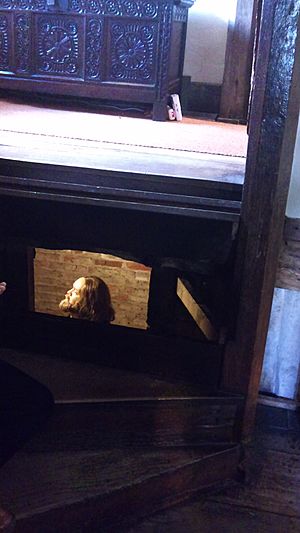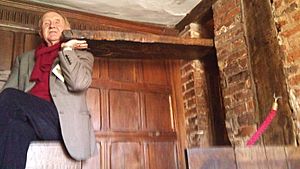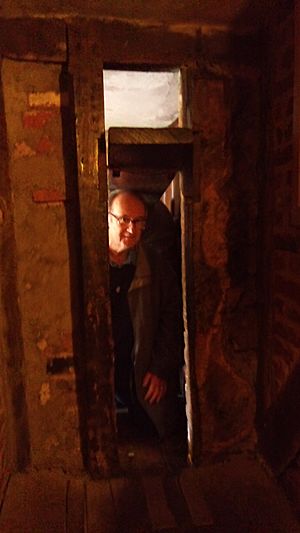Nicholas Owen (Jesuit) facts for kids
Quick facts for kids SaintNicholas Owen SJ |
|
|---|---|
| Martyr | |
| Born | c. 1562 Oxford, England |
| Died | 1/2 March 1606 (aged 43 - 44) Tower of London, England |
| Venerated in | Roman Catholic Church |
| Beatified | 15 December 1929 by Pope Pius XI |
| Canonized | 25 October 1970 by Pope Paul VI |
| Feast | 22 March (individual) 4 May (Forty Martyrs) |
Nicholas Owen, a member of the Society of Jesus (S.J.), was born around 1562 and died on March 1 or 2, 1606. He was an English Jesuit lay brother. He became famous for building many secret hiding places called "priest holes." He created these during the reigns of Queen Elizabeth I and King James I of England.
Owen built these priest holes in the homes of English Catholics from 1588 until his final arrest in 1606. He was then tortured to death by prison officials in the Tower of London. The Catholic Church honors Nicholas Owen as a martyr. He was made a saint by Pope Paul VI in 1970.
Contents
Nicholas Owen's Life
Nicholas Owen was born around 1562 in Oxford, England. He came from a very religious Catholic family. He grew up during a time when "Penal Laws" were in place. These laws made it very hard to be Catholic in England.
His father, Walter Owen, was a carpenter. Nicholas became an apprentice to a joiner (a skilled woodworker) in February 1577. This training gave him the special skills he would later use to build secret hiding places. Two of his older brothers became priests.
Owen first worked as a servant for Edmund Campion, a priest. Campion was arrested by "priest hunters" in 1581. Nicholas himself was arrested for saying Campion was innocent. After he was released, he began working for Henry Garnet, a Jesuit, around 1588.
For the next 18 years, Owen built secret rooms for Catholic priests in the homes of Catholic families. He often traveled from one house to another. He used different names like "Little John," "Little Michael," "Andrewes," and "Draper." He only accepted what he needed to live as payment before moving to a new project. During the day, he pretended to be a traveling carpenter to avoid suspicion.
Nicholas Owen was a very short man. He also had a hernia and a leg that was hurt when a horse fell on him. Even with these challenges, his work often involved breaking through thick stone walls. To keep his secrets safe, he usually worked at night and always alone.
Sometimes, he would build an outer hiding place that could be easily found. This outer spot would then hide a deeper, more secret room. Only Nicholas and the owner of the house knew where the true secret room was. Some of his amazing hiding places can still be seen today. You can find them at Sawston Hall in Cambridgeshire, Oxburgh Hall in Norfolk, Huddington Court in Worcestershire, and Coughton Court in Warwickshire. Harvington Hall in Worcestershire has seven "priest holes" that he made. Because of his clever designs, some of his hidden rooms might still be undiscovered.

For many years, Owen worked for the Jesuit priest Henry Garnet. He was accepted into the Society of Jesus as a lay brother. He was arrested in 1594 and tortured at the Poultry Compter prison. But he did not reveal any secrets. He was released after a rich Catholic family paid a fine for him. The jailers thought he was just an unimportant friend of some priests. He then went back to his work. People believe he planned the famous escape of John Gerard from the Tower of London in 1597.
In early 1606, Owen was arrested for the last time at Hindlip Hall in Worcestershire. He gave himself up on purpose. He hoped to draw attention away from his master, Garnet, who was hiding nearby with another priest. When officials realized who they had caught, they were very happy. Robert Cecil, a powerful government official, said: "It is unbelievable how happy we were about his arrest... knowing how skilled Owen is at building hiding places, and the countless secret holes he had planned for hiding priests all over England."
Nicholas Owen's Death
After his arrest, Owen was first taken to the Marshalsea prison, located on the southern bank of the Thames River. Then, he was moved to the Tower of London. He was tortured on the Topcliffe rack. This torture involved hanging him from a wall with his wrists held tightly in iron gauntlets. His body was left dangling. Because of his hernia, his insides would bulge out during this painful process. So, the torturers strapped a round iron plate to his stomach.
When he still refused to speak, he was likely moved to a different rack. This machine used a windlass (a type of crank) to stretch the body even more. It is believed that this severe stretching caused his hernia to worsen greatly, leading to his death. Owen did not tell his questioners anything. He died during the night between March 1 and 2, 1606.
John Gerard, the priest Owen helped escape, wrote about him:
I truly believe no one did more good among all those who worked in England. He directly saved the lives of many hundreds of people, both religious and everyday people.
Becoming a Saint
Nicholas Owen was made a saint (canonized) as one of the Forty Martyrs of England and Wales by Pope Paul VI on October 25, 1970. Their shared feast day (a special day of celebration) was first celebrated on the anniversary of their canonization. That feast day has now been moved in England to May 4. His individual feast day is on March 22.
Catholic stage magicians who perform "Gospel Magic" consider Saint Nicholas Owen their patron saint. He is seen as the patron saint of illusionists and escapologists. This is because he was so good at using trompe-l'œil (a trick of the eye) when he created his hidden rooms.
There are Roman Catholic churches named after Saint Nicholas Owen in Little Thornton, Lancashire, and Burton Latimer, Northamptonshire. A Catholic school company that serves the Kidderminster, Hagley, and Stourbridge areas near Harvington Hall is also named in his honor.
Nicholas Owen in Stories
- Owen appears as a small character in Robert Hugh Benson's novel Come Rack! Come Rope! (1912). In this book, he is called "Hugh Owen."
- One of his priest holes is very important in the Catherine Aird mystery novel A Most Contagious Game (1967).
- A priest hole believed to be made by him is also part of Peter Carey's novel Parrot and Olivier in America (2010).
- Owen and his work are key parts of The House of a Hundred Whispers by Graham Masterton, published in 2020.
- Owen is also a small character in Leonard Tourney's novel Catesby's Ghost: A Mystery of Shakespeare (2022).
See also
- Priest hole
- Priest hunter
- Richard Holtby



